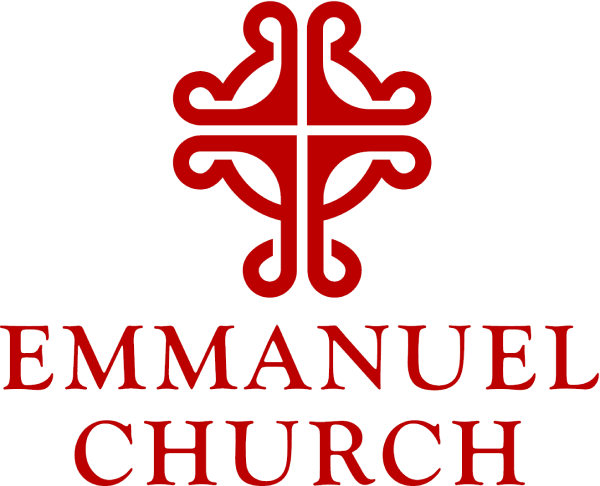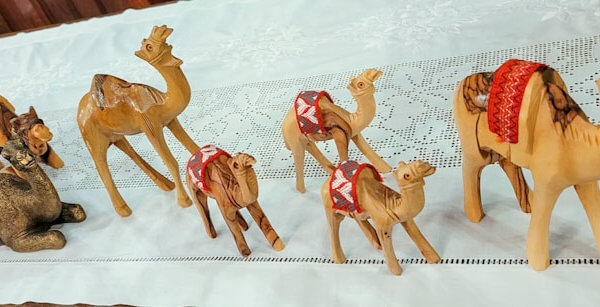
The New Advent
 Mark’s gospel today is Jesus’ prophecy about the end times when all will see the Son of Man “coming in the clouds” with great power and glory from the Book of Daniel. Remember that Jesus was a good Jew who knew his scripture. The Book of Daniel, and Jesus’ prophecy in Mark, are all about watching for the signs that point to, and remind us, to stay awake — to stay hopeful — that we will see our savior come. We read that passage in Advent because it reminds us to wait and hope for God incarnate to be born.
Mark’s gospel today is Jesus’ prophecy about the end times when all will see the Son of Man “coming in the clouds” with great power and glory from the Book of Daniel. Remember that Jesus was a good Jew who knew his scripture. The Book of Daniel, and Jesus’ prophecy in Mark, are all about watching for the signs that point to, and remind us, to stay awake — to stay hopeful — that we will see our savior come. We read that passage in Advent because it reminds us to wait and hope for God incarnate to be born.
So how will we wait and hope this Advent? Many of us who are lifelong Episcopalians have been taught all our lives that Advent is the season of hushed expectation, where we wait — quiet and hopeful — for Jesus’ birth. And for most Episcopalians — I know that I grew up this way — there’s a kind of almost Puritan abstemiousness about Advent.
In some Episcopal churches, especially in the United States and in the Church of England, congregations observe Advent as a season of penitential self-denial, like a mini-Lent — with no Christmas decorations, Christmas tree, or, for heaven’s sake, Christmas hymns — until Christmas. We see that a little bit here at Emmanuel. The vestments I’m wearing today are purple, as they are in many Episcopal churches during Advent. They’re the same ones we use for Lent. In other Episcopal churches, Lenten vestments are blue.
While the use of color in vestments and altar hangings is ancient, it’s important to remember that Jesus doesn’t tell us in scripture that we must use blue or purple at Advent. The mothers and fathers of our faith didn’t write in ancient documents that if we wore red instead, like we do at Pentecost, that our worship wouldn’t sustain our faith. But our traditional colors are signs for us. They point to, and remind us, of what is really important about the season. What color we use to remind us of that time has more to do with our culture — where we grew up, what foods we ate, what the weather was like there, what games we played, what pets we had — than it does a basic tenet of our faith.
Decorate Extravagantly
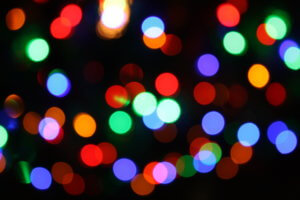 In Jerusalem, for example, all three communities of faith — Christians, Muslims, and Jews — decorate extravagantly for their principle holidays, and they all use the kind of lights that we think of and call Christmas lights. Interestingly, both the Muslims and the Christians use a lot of blue Christmas lights. In the United States, Hallmark cards have taught us to think of blue as a Hanukkah color.
In Jerusalem, for example, all three communities of faith — Christians, Muslims, and Jews — decorate extravagantly for their principle holidays, and they all use the kind of lights that we think of and call Christmas lights. Interestingly, both the Muslims and the Christians use a lot of blue Christmas lights. In the United States, Hallmark cards have taught us to think of blue as a Hanukkah color.
The Jews ALSO decorate at Hanukkah with lights, and some of those lights are blue and gold. But they also use some red and green. And at Ramadan, the amazing annual Muslim celebration of kindness and generosity, the Muslim neighborhoods compete for the most extravagant decorations — also of colorful Christmas lights, hung with moons and five-point stars, which are symbols of Islam.
Those lights are signs that point to, and remind people of, their deepest emotional and spiritual truths about Christmas — or Hanukkah, or Ramadan, just like camels are signs that point us toward, and remind us of, the magi — and how far they traveled, over what rough conditions, to arrive in Bethlehem to see the baby Jesus. It’s not a specific color that matters to God. It’s the color that is specific to the individual’s experience with God that matters. That is the sign.
It’s the same with our familiar Episcopal church “rule” about no Christmas decorations and hymns before Christmas Eve. God didn’t tell us to wait to put up the tree. The mothers and fathers of the church didn’t write it down in ancient scrolls. The practice of waiting to decorate developed as a sign, to point to, and remind us of, the coming of our savior — Jesus’ birth. In the late 20th century, people began to associate the lights and the decorations with the commercialism of Christmas, so for Episcopalians, waiting to decorate was a kind of countercultural expression — to focus on our hope for things to come.
In Jerusalem, where Christians represent less than 2% of the total population, they put up their bold, extravagant, and bright Christmas decorations by the end of November — more than three weeks before any kind of Episcopalian “Advent Orthodoxy” would allow. But for the tiny minority of Christians in Jerusalem, showing up loud and proud with their Christmas decorations IS countercultural. As my friend Abed in the St. George’s Guest House says, we have to show everyone that we are here, and that this is our special holiday.
Show Up Loud, Proud, and Early
 Maybe in this strange pandemic Advent — separated for the past nine months from our friends, families, and many of our traditions — WE should show up loud, proud, and EARLY with our Christmas decorations. That may be the perfect sign to point to, and remind us of, our hopeful waiting for Jesus’ birth, just like camels remind us — or me, anyway — of waiting, hoping, and traveling toward Jesus.
Maybe in this strange pandemic Advent — separated for the past nine months from our friends, families, and many of our traditions — WE should show up loud, proud, and EARLY with our Christmas decorations. That may be the perfect sign to point to, and remind us of, our hopeful waiting for Jesus’ birth, just like camels remind us — or me, anyway — of waiting, hoping, and traveling toward Jesus.
Maybe this COVIDtide where so many have experienced so much isolation and loss — of loved ones, jobs, and treasured traditions — we can watch for different signs. Or see the traditional signs differently. So here’s the deal: if wearing your favorite Christmas sweater brightens your day, please haul it out of storage and put it on now. Let’s play our Christmas hymns — right away. Go ahead and put up the tree.
I’ll tell you what I’m going to do — I’m going to put out all of my camels, as camels are signs of the long journey of the magi from the East from the moment they begin to follow the star to Bethlehem. Camels are all about waiting, hoping, traveling, and yearning toward the incarnate God born in Bethlehem. Some of you who do not love camels as much as I do may find a different sign of hope — maybe your favorite pair of Christmas jammies, or put a wreath on the door.
The point is that thinking of Advent differently this year is not rushing Christmas. Seeing different signs pointing to, and reminding us that our savior is coming is not commercialism distracting us from our focus on Jesus’ birth. In this paused, pandemic Advent, our early Christmas lights are bright spots of hope shining out, resilient and determined, even as we wait. Amen
Advent Wreath
The first candle is for Hope: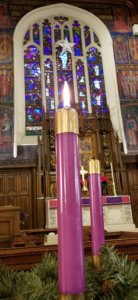
Come, O Holy One,
as the morning light after a wakeful night!
Keep us mindful that at any moment you may ask of us
an accounting of our lives;
help us to love you and love one another in all we do,
and so clothe us with your light
that we may bring others to love you also,
through Jesus our Savior. Amen.
Collect
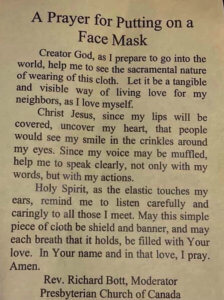
Family Meeting
- Please read your Constant Contact for more detailed announcements each week.
- In his visit, Bishop Knisely clarified that our online worship should be streamlined, at about 30-40 minutes. This is a better length both for the safety during COVIDtide of the worship team and is a better length for the experience of worshiping online, as opposed to in person. He encourages us to stay online during the surge in cases. Reminder that the State of Rhode Island two week Pause begins November 30.
- What else feeds us during these times? Would you like to return to Rite I for some services? Would the trial use of Enriching Our Worship that Bishop Knisely used in Thanksgiving Day Morning Prayer be fulfilling? An Agape Meal? Morning Prayer during the week? We are both limited and have enormous flexibility.
- On November 20, 2020, the board of the Newport Music Festival approved the listing of their office condominium in Middletown and the move to Emmanuel Church upon the sale of the condo.
- Join us Wednesday evenings for conversation in the Gathering Circle.
